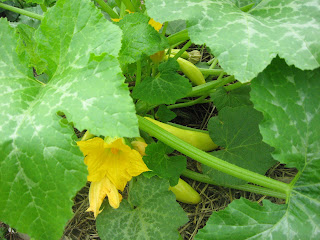July presents us with the perfect time to give our gardens a proper check-up. First, you probably want to rid the area of weeds. Weeds will compete and ultimately win the competition for space, water, and nutrients. If you keep the weeds to a minimum, your vegetable plants can give you their maximum. Weeds also harbor insects that will attack your crops. Check the plants closely. Look at everything. Start at the base of the plant and look for signs of disease or damage caused by insects. Be sure to check the underside of leaves and the areas where leaf and stem meet. If you see anything out of the ordinary now is the time to treat the problem and rid the plant of the stressors.
Plant for late harvest
You can still do some planting in July to continue the harvest into the fall. Squash, cucumbers, cilantro, basil, and dill will still grow fast enough to produce a harvest before frost. A late crop of tomatoes may still be planted in early July. If you have extra tomatoes, chop them and freeze for sauces and soups later. If you are growing for the goal of preserving, you may want to plant successive crops two to four weeks apart to keep the bounty coming. This will allow you time to prepare each crop for preserving without being overwhelmed. Likewise, if you are planting just for consumption, planting in succession will keep fresh veggies coming to the table for you and your family well into the fall.
Fertilize your heat-loving plants
You should have fertilized your plants when you planted them. Now is the time to do it again. Replenishing the ground with nutrients can help your plants make it through the hottest part of the summer without all the stress. If you use a slow-release fertilizer you likely won't have to do it again this season. But, if you prefer to use a water-soluble fertilizer such as Miracle-Gro, you may want to do it about every week.
Plan Your fall veggies.
On the really hot days, you may want to stay inside and put some thought into planning your cool weather crops. It is still a bit early to plant as most cool weather crops do not grow well in the heat of summer. Hence, their cool weather classification. If you are like me, making a plan is the easy part. Executing it is when the real work begins. Now is the perfect time to do some research and plan what, when, and where you want your cool crops to go.
Last, but not least, you may want to keep a journal of your garden journey if you are new to the gardening scene. Write down what you have planted, where it is, how it is doing along the way, and how many you planted of each.
Make a note of any pruning or fertilizing you do as well as the varieties that you planted. If something didn't work so well this year, make a note of that too and do something different for next year. Once you get something that works, make a note of that as well so that you can repeat it in the following years. It is also good practice to make note of the weather, maybe not daily but at least weekly so that you can use that as a reference tool for the future. A rain gauge is cheap and helps you track the actual rainfall.
Gardening is not complicated. However, there is a science to it for sure. If you are a novice, you will learn from your mistakes. If you are a seasoned pro you have learned from your mistakes and will continue to make new ones. There is no way to have a perfect plan. Sometimes you will get it right, and sometimes everything goes wrong. We cannot control every aspect but we can do our best to put all the pieces into play that your plants will need to grow successfully. When mother nature gives you drought, you water, water, water. Watering should be done in the morning to afternoon. Be careful not to water in late day so plants won't stay wet all night, which causes disease. Always be sure there is no hot water in the water hose when you water. When she gives you rain, you pray, pray, pray. No matter how it turns out, enjoy the journey and the challenges. After all, that is what it is all about.



No comments:
Post a Comment